

Sparkman & Stephens 45 ft New York 32 1936 - Sold
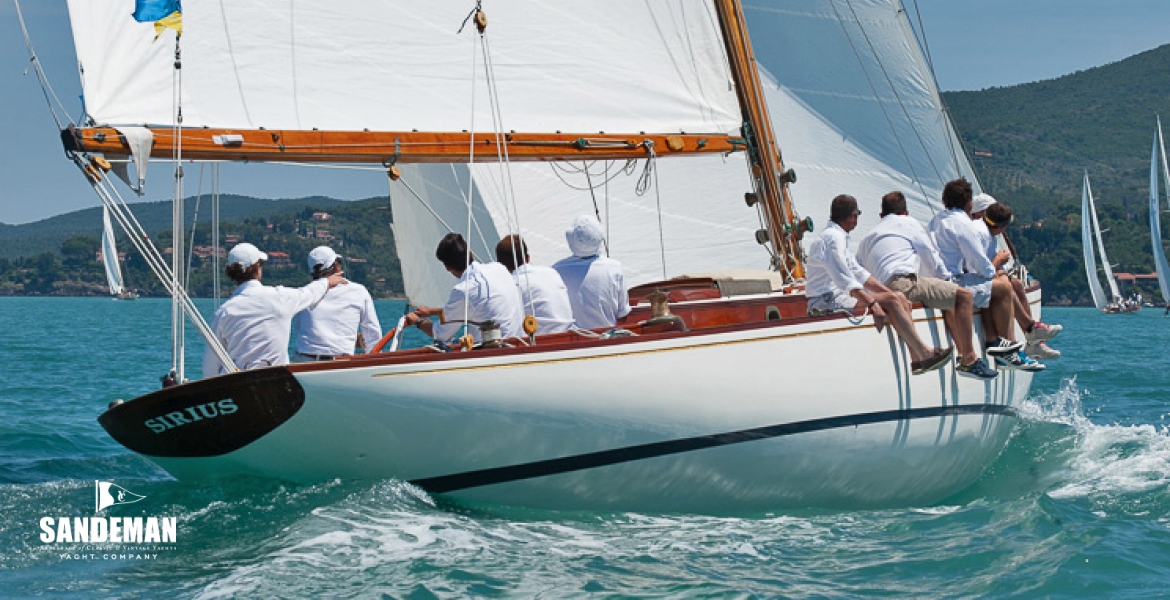
Sparkman & Stephens 45 ft New York 32 1936
These details are provisional and may be amended
BROKER'S COMMENTS
The New York 32 always had a hard act to follow the legendary Herreshoff designs as the New York Yacht Club club boat but over the years in every type of race, these boats have exceeded expectations – evolving from the iconic designs of DORADE and STORMY WEATHER, the 32s were the expression of a trend with their reduced sail area, easy sections and outstanding sea-keeping. SIRIUS after an extensive restoration by Cantiere Navale in Argentario in 2006 has nevertheless retained almost all of her original detail; her period Merriman deck fittings and her interior fully retaining its classic 1930s ambience. Under new ownership in 2013 the boat has since been totally optimised to classic race using the services of Sparkman & Stephens New York to make sure she sails as she would have done in the 1930s – in every sense from sail plan to trim – and the race results say it all !
Accommodation and domestic equipment
The interior of SIRIUS is wonderfully true to her period – her restoration keeping the varnished mahogany panelled bulkheads, carefully painted white deck heads and varnished solid teak sole for which Nevins were famous. Not to comment here on the attention to detail of fittings, hatches, catches, lamps, brass work and glass would be missing out on the elements that maintain her 1930s character and make SIRIUS a very special yacht. From the sliding hatch in the coach roof 6 companionway steps descend to saloon - 2 x Beige button back leather settees, port & starboard - Stowage outboard in glass fronted lockers - Gimballed table on centreline - Butterfly skylight hatch over - 3 x Opening ports - 3 x Deck head lights - Navigation instruments behind mahogany panel above stbd settee aft - Fiddled panelled chest of drawers fwd to stbd - Deep hanging locker to stbd with isolator panel concealed within Head compartment to port - Opening port - 1 x Deckhead and 1 x bulkhead light and paraffin lamp - Vanitory mirror - Manual WC - Ceramic basin H&C - Shower Door to Galley to port - 4 x Opening ports and small hatch in deck head fwd part of trunk cabin - Ceramic sink with original taps - Small camping gas 2 burner hob in container - Shelving for plates and crockery - Top loading fridge across to stbd Focsle - Access to foredeck by hatch in deckhead - 2 x single berths - Extensive stowage for sails, lines, sheets etc - Flag locker - Original “paid hands” fold away basin Coming aft through the saloon and past the companionway steps to Double master stateroom - 2 x berths; one each side with stowage under - Desk on centreline - Vanitory mirror - Access to lazarette P&S - Compass in deck head - Barometer - Small butterfly hatch in deck head - 2 deck head lights - 2 bulkhead lamps
Construction
- Philippine mahogany on white oak frames with Everdur fastenings - Steam-bent oak frames on 8 inch centres - Ply deck sheathed and painted
The 1930s were characterised by sailing fever, even with the Great Depression, Americans continued to invest in yachting. The members of the New York Yacht Club (NYYC) wanted to cross oceans and compete in offshore regattas including the Newport to Bermuda – this was impossible in the club’s boat of the time, the NY 30. The ladies also complained about the lack of space below deck; the criticism was “too much sail to go to sea without a seaman and too little space to accommodate one”. To replace the NY 30, in 1936 Commodore W.A.W. Stewart organized a competition for the design and construction of the Club’s new boat, calling the best naval architects: John Alder, Luders, Ford & Paine, W J Roue, Belkar & Paine and Sparkman & Stephens. The instructions were a waterline no less than 30 feet, accommodation for 4 guests and one crew and the Scantling Rules of Lloyds. Olin Stephens was chosen and Henry B. Nevins Shipyard of City Island offered to deliver all the boats within 1 year – on completion of the 20 boats the tooling was destroyed as required by the NYYC. According to the magazine, The Rudder, “ .….the club did not want a crowd on the starting line and, above all, if the class were enlarged, the boats could end up in undesirable hands.” The boats were given sail numbers 1-20. SIRIUS originally named DOLPHIN bore sail number 19 and has always been NY 19. The first owner was Henry Sturgis Morgan, of the famous banking dynasty and the founder of Morgan Stanley, another leading investment bank. He was a prominent yachtsman, Commodore of the NYYC and Chairman of the America's Cup committee, winner also of the Astor cup and the Kings cup. It was he who had named NY19 DOLPHIN BUT after him NY19 was renamed AWAY and finally SIRIUS. From the late 30s to the 1970s, NY 19 was raced extensively on the east coast of the USA. She raced several times in most of the toughest races on the east coast, including Miami-Nassau, Annapolis-Newport, the Lipton Race and Newport-Bermuda. NY 19 moved to the Mediterranean on 2005. After extensive restoration by Cantieri Navali dell' Argentario she was raced in 2007 and 2010 with the following results; - 1st in class at Antibes 2007 - 3rd in class Regates Royales 2007 - 3rd in class Argentario Sailing week 2007 - 2nd overall Panerai Yacht challenge 2007 - 1st in class Argentario Sailing Week (2010) In 2013 / 2014 under new ownership, and after a refit with classic racing in mind at the Cantieri Navali dell Argentario, NY19 was raced extensively with further excellent results; 2013 - Winner of Vele d'Epoca in Naples - Class winner at Argentario Sailing week and Regates Royales at Cannes - 2nd in class at Voiles de St Tropez and Antibes - Winner of the Cannes -St Tropez Regatta 2014 - Winner of the Copa del Ray at Mahon; - Winner of the Sparkman & Stevens Regatta - Class winner at Regates Royales at Cannes, Vele d'Epoca at Imperia and Vele d'Epoca at Naples - 3 rd in class both at Antibes and Voiles de St Tropez
Rig, spars and sails
Bermudan sloop rig - Sitka spruce double spreader mast with diamonds and original Merriman fittings - 4 x Halyard winches - Spinnaker pole track on fore edge of mast - Sitka spruce boom - Spinnaker pole mounted on blocks port side fwd Sails - Racing mainsail 2013 Zaoli - Cruising mainsail 2013 Zaoli - Light Genoa 2013 Zaoli - Light Genoa 2014 Zaoli - Medium Genoa 2013 Zaoli - Medium Genoa 2014 Zaoli - Heavy Genoa 2013 Zaoli - Jib 2006 Olympic - Large spinnaker 2013 Zaoli - Small spinnaker 2006 Plus - Old gennaker 2013 Zaoli - Large gennaker 2014 Zaoli - Small gennaker 2014 Zaoli - Swedish main sail 2008 Zaoli
Deck layout equipment and ground tackle
From Bow - Varnished mahogany toe rail - Bronze stanchion bases - White painted deck - Bronze stem head fitting with fairleads P&S - Forestay load cell - Bronze anchor windlass - Delta aluminium anchor c 60 ft / 20 m chain and c 100 ft / 30 m rope - Raised foredeck hatch - Bronze shroud turnbuckles with leatherwork covers - Iconic NY 32 trunk cabin with varnished sides and bronze ports - Raised hatch at fore end of trunk cabin with halyard bag fitted also as cover - Mast with dorade box vents both sides - Varnished teak handrails running fore and aft over coach roof both sides - Butterfly skylight hatch - Hallmark wide side decks for ease of crewing - 3 x sockets for alternative jib car block positioning set in each side deck - Main companionway hatch sliding under bronze cover offset to stbd aft end of trunk cabin - 2 x Main sheet blocks to Nevins No 3 winch at aft end of coach roof - Small butterfly hatch over aft cabin also serves as access hatchway - All Merriman ash blocks; those at deck level protected with leather covers - Large uncluttered centre cockpit with large bridge deck and elegant compass and binnacle - Stowage for life raft - 2 x Original Merriman primary winches on teak blocks outside cockpit coamings - Bronze Genoa tracks on toe rails both sides - Chromed sheave blocks to toe rail - 2 x Merriman bronze secondary winches for running backstay and spinnaker - Running backstay with varnished ash blocks protected by leatherwork - Chromed compass binnacle by bridge deck - Navigation instrument repeaters in cockpit fore bulkhead with mahogany covers - Yanmar engine controls fwd to port and instruments hidden by sliding hatch - Tiller steering - Varnished boom gallows - Varnished lazarette hatch with bronze mushroom vent abaft cockpit - Mainsheet purchase blocks attached to aft deckhead Bronze mooring cleat on centreline - Bronze fairleads port and stbd - Bronze Herreshoff style blocks for backstay to taffrail - Bronze stern light
Mechanical electrical and tankage
- Yanmar Diesel engine 2014 with charging alternator - 2 bladed SWP folding propellers - 12 V Electrical circuit - 2 x Domestic batteries 12 V 110 V - 1 x 12 V 80 A engine start battery - 220 V with 2 power outlets - Victron Blue Power 12 V 30 A - 1 x 130 litre stainless steel fuel tank under saloon seating - 1 x 130 litre stainless steel fresh water tank under saloon seating - c 25 litre gray water tank and auto pump
Navigation, communications and electronics
- Wilfred O White & Sons Inc original steering compass in binnacle - Raymarine ST2 90 navigation system incl autopilot - 2 x Displays; 1 each side - CD player
- 1 x 6 Person life raft - 1 x Rule automatic bilge pump - 1 x Marco manual bilge pump with long hose
Refit 2013 14
During the winter of 2013 14 SIRIUS returned to Cantiere Navale Argentario for a focussed refit to optimise the boat for classic racing. Works included - New rudder - Stripping the hull back, re caulking and fairing - New sea cocks and skin fittings - Full Awlgrip paint treatment - New engine, transmission and ancillaries fitted under close supervision of S&S New York - New fuel and water tanks - New electrical systems, batteries etc - New instruments - Stripping bright work back to bare wood and full 12 coat varnish system - Application non slip to deck and coach roof Details of these and the full list of lesser works are available.
Original tender
SIRIUS comes with an original Nevins built clinker tender with oars and sailing rig
These particulars have been prepared from information provided by the vendors and are intended as a general guide. The purchaser should confirm details of concern to them by survey or engineers inspection. The purchaser should also ensure that the purchase contract properly reflects their concerns and specifies details on which they wish to rely.
Sandeman Yacht Company
Brokerage of classic & vintage yachts.

- Featured News
- The Next Generations of the NY32, Apache
- Kate Wilson
- June 10, 2020
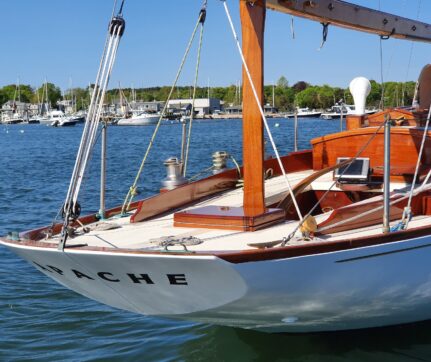
Tyson Streeter never owned a wooden boat before, let alone a sailboat. Aside from a Laser and a Boston Whaler, his boat ownership had a limited past. However, that never slowed his passion for sailing or wooden yachts, his aunt started at Wooden Boat Magazine in 1978 and created their famed calendars, which have hung in Streeter's home ever since. So it was on his wall in July 2018, that he gazed upon a pair of NY 32s rafted together, and the rest is history.
"The lines struck me. Everything about the boat stuck out for me," says Streeter from his home in Cohasset, Massachusetts, where he has been staying at home with his wife, six-year-old twins, and a five-year-old eagerly awaiting the summer sailing season. "I just said to myself: 'That's the boat I am going to get.'"
He sought out the advice of one of the owners of those depicted NY 32s, Peter Cassidy - who also happens to own and operate Buzzards Bay Yacht Services and also has a young family he sails with on his NY32, Siren . With Cassidy's counsel, they looked at one for sale in Maryland but walked away underwhelmed as the boat had undergone significant refits already and felt less authentic.
However, Peter did not give up on Tyson's dream, he knew that many NY 32s moved after World War II to the Great Lakes region, and while no boat was listed, "all boats are always for sale." After speaking with Skip Gmiener, owner of Apache NY 32 Hull #2, on a Monday, they flew to Detroit on Friday and had a deal by Monday with Gmiener happy to see the boat going to an owner with such passion.
Gmiener's father bought the Sparkman & Stephens designed boat in 1940 just four years after she launched on May 9, 1936, as part of a 20 boat fleet commissioned by the New York Yacht Club. Apache sailed the Bermuda Race that year (the first year the race started in Newport) and finished 2nd of 44 boats. This edition was also the famed Bermuda Race that gave us the Storm Trysail Club as it was a harrowing voyage to the Onion Patch that year, and those who finished were highly-regarded mariners.
Apache in her slip that she held for 78 years.
In 1938, the original owner, Buz Havamire, sold her to Tommy Fisher, who brought her Gross Pointe Yacht Club. There Skip's father, Toot, was one of Fisher's crew. As the war was starting to ramp up, Toot Gmeiner bought Apache from Fisher in the Fall of 1940 and brought her to Detroit Yacht Club, where she remained for 78 years before Streeter had her trucked in the December of 2018 to Buzzard Bay Yacht Services in Mattapoisett, Massachusetts.
[more history as told by Skip Gmeiner https://youtu.be/V_i9sHPN_fE ]
Streeter describes the time once Apache arrived at Cassidy's shop as the "winter of the bad phone call." They discovered hidden rot and issues the survey could not produce. "He is a great craftsman, and he knows this very wooden boat - every plank and joint. It was still an incredible educational experience."
During the Winter of 2018 - 2019, they decided that due to rot that had been epoxied over, the entire stem needed to be replaced. Luckily, down in wooden boat enthusiast Elizabeth Meyer's, barn, they found the perfect stem piece originally from the Danish Royal Forest, woods that had been grown specifically for shipbuilding.
Rotting stem
"The speed and skill in which they detached the planks from the rabbit and repaired rotted horn timber were incredible," explained Streeter. "As with any project, things pop up and the keel had to be dropped to repair bolt and then get rebedded back up. It was troubleshooting all the time but I am grateful to have had Peter leading this."
After getting the boat below the waterline in order, they launched Apache for a summer of sailing in 2019. Aside from daysailing, the entire young family took part on a week-long cruise onboard the 32-footer to the North Shore of Massachusetts Bay.
"The kids loved it so much they were actually mad to get off the boat. We were lucky the family fell in love."
Streeter took part in the Corinthian Classic Regatta sailing with friends and had a great time. He even took home the "American Friendship Trophy" which was bestowed upon him from the previous year's winners, the crew of Neith . It is given for someone who exhibits a standout sailing passion and awards the winner with a trip Germany to sail in a classic yacht regatta. This year's trip has been postponed, but it was a humbling experience for Streeter.
"I leaned into my wife during the awards and said 'Hey, I hope we can get that someday because that is us!' Then I was floored when I heard our name," he admitted.
After a successful first season with Apache , she returned to Cassidy's shop with a winter goal to keep fresh water out of the boat. The deck was glassed over in the 1980s with the combings still on, so some water damage rotted a few deck beams causing it to rain in the aft berth. The spars also needed to be redone.
"We were able to get a beautiful piece of Maghony from Newport Nautical Timbers for the combings, winch pedestals, and might even have some leftover for a cockpit table," explained Streeter. "The combings came out just beautiful. They were steamed into place by Peter who now is looking to use the jig on his boat! This process also allowed me to place the winches where I wanted them.”
Now that the deck and hull are tightened up, the family is looking forward to emerging from quarantine and sailing together once again. Apache splashed on May 20, 2020. Aside from local cruising, they are planning to sail down to New London so the kids can participate in a junior program near extended family and explore those waters.
"Peter is truly an artist when it comes to preserving these boats. It is the history and tradition that made me first fall in love with wooden boats, and I am happy to pass that on. I am hoping our children will be the next owners," concluded Streeter.
Thanks to our Diamond and Gold Partners
Interested in becoming a partner of the cyoa join as a partner online or contact us at info @ classicyachts.org for details..
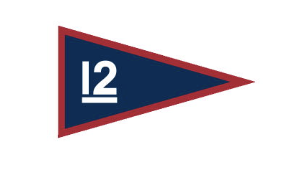
SPERRY SAILS

The Classic Yacht Owners Association is an exempt organization as described in Section 501(C) (3) of the Internal Revenue Code. Donations and membership fees are charitable contributions and tax-deductible. Employer Identification Number: 81-285925
© Copyright 2024. All Rights Reserved. Website by risingT, LLC.
New york yacht club 32
The new york yacht club 32 is a 45.33ft fractional sloop designed by olin stephens and built in wood by nevins inc. between 1935 and 1936., 20 units have been built..
The New york yacht club 32 is a heavy sailboat which is a good performer. It is not stiff and has an excellent righting capability if capsized. It is best suited as a heavy bluewater cruising boat.
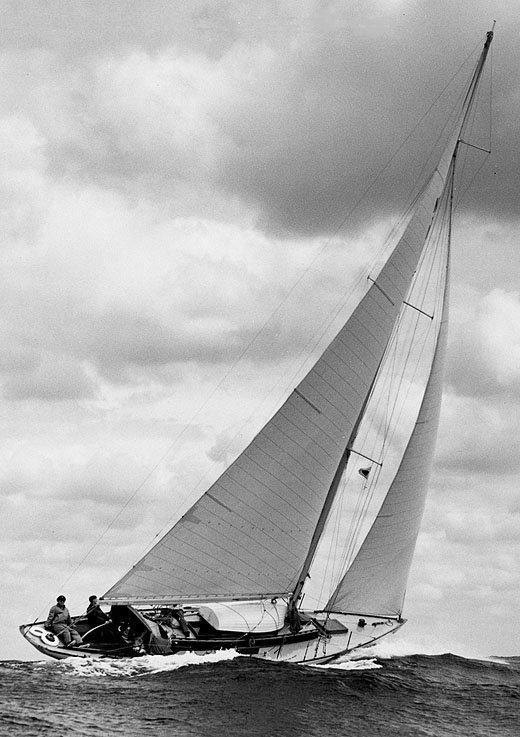
New york yacht club 32 for sale elsewhere on the web:

Main features
Login or register to personnalize this screen.
You will be able to pin external links of your choice.

See how Sailboatlab works in video

We help you build your own hydraulic steering system - Lecomble & Schmitt
Accommodations
Builder data, other photos.
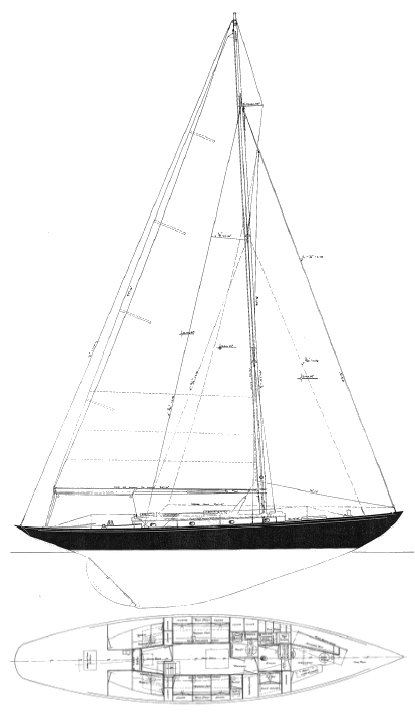
Modal Title
The content of your modal.
Personalize your sailboat data sheet
Boats for Sale & Yachts
Sparkman and stephens new york 32 1936 1936 boats for sale & yachts, sparkman and stephens boats review and specs.
Table of Contents
MUSTANG is famous – not only as one of the small fleet of NY 32s designed by Olin Stephens as the club boats for the New York Yacht Club in 1936 but as his brother Rod’s own race winning boat for more than 20 years. The stories of this boat and Rod Stephen’s racing and cruising her are the stuff of legend in jottings and editorials of the yachting press of that era.
Contact Information
Sparkman and Boats for Sale Craigslist & Sparkman and Specs & Pictures
Related posts:.
- Sparkman & Stephens New York 1936
- Sparkman & Stephens/Nevins New York 32 1936
- New York 32 1936
- Rod Stephen’s New York 32 Mustang 1936
This entry was posted filed under Sailboats for Sale . You can follow any responses to this entry through the RSS 2.0 feed. You can skip to the end and leave a response. Pinging is currently not allowed.
Great choice! Your favorites are temporarily saved for this session. Sign in to save them permanently, access them on any device, and receive relevant alerts.
- Sailboat Guide
New York Yacht Club 32
New York Yacht Club 32 is a 45 ′ 4 ″ / 13.8 m monohull sailboat designed by Sparkman & Stephens and built by Nevins Inc. between 1935 and 1936.

Rig and Sails
Auxilary power, accomodations, calculations.
The theoretical maximum speed that a displacement hull can move efficiently through the water is determined by it's waterline length and displacement. It may be unable to reach this speed if the boat is underpowered or heavily loaded, though it may exceed this speed given enough power. Read more.
Classic hull speed formula:
Hull Speed = 1.34 x √LWL
Max Speed/Length ratio = 8.26 ÷ Displacement/Length ratio .311 Hull Speed = Max Speed/Length ratio x √LWL
Sail Area / Displacement Ratio
A measure of the power of the sails relative to the weight of the boat. The higher the number, the higher the performance, but the harder the boat will be to handle. This ratio is a "non-dimensional" value that facilitates comparisons between boats of different types and sizes. Read more.
SA/D = SA ÷ (D ÷ 64) 2/3
- SA : Sail area in square feet, derived by adding the mainsail area to 100% of the foretriangle area (the lateral area above the deck between the mast and the forestay).
- D : Displacement in pounds.
Ballast / Displacement Ratio
A measure of the stability of a boat's hull that suggests how well a monohull will stand up to its sails. The ballast displacement ratio indicates how much of the weight of a boat is placed for maximum stability against capsizing and is an indicator of stiffness and resistance to capsize.
Ballast / Displacement * 100
Displacement / Length Ratio
A measure of the weight of the boat relative to it's length at the waterline. The higher a boat’s D/L ratio, the more easily it will carry a load and the more comfortable its motion will be. The lower a boat's ratio is, the less power it takes to drive the boat to its nominal hull speed or beyond. Read more.
D/L = (D ÷ 2240) ÷ (0.01 x LWL)³
- D: Displacement of the boat in pounds.
- LWL: Waterline length in feet
Comfort Ratio
This ratio assess how quickly and abruptly a boat’s hull reacts to waves in a significant seaway, these being the elements of a boat’s motion most likely to cause seasickness. Read more.
Comfort ratio = D ÷ (.65 x (.7 LWL + .3 LOA) x Beam 1.33 )
- D: Displacement of the boat in pounds
- LOA: Length overall in feet
- Beam: Width of boat at the widest point in feet
Capsize Screening Formula
This formula attempts to indicate whether a given boat might be too wide and light to readily right itself after being overturned in extreme conditions. Read more.
CSV = Beam ÷ ³√(D / 64)
Designed and built as a replacement for the Herreshoff NYYC 30s. A few of these yachts have been restored and are still sailing. (2009)
Embed this page on your own website by copying and pasting this code.
- About Sailboat Guide
©2024 Sea Time Tech, LLC
This site is protected by reCAPTCHA and the Google Privacy Policy and Terms of Service apply.
Refastening a Wooden Hull - Season 4, Episode 1 Now Available!
How to Build a Wooden Mast
A tapered, oval new york 32 spar from the original plans.
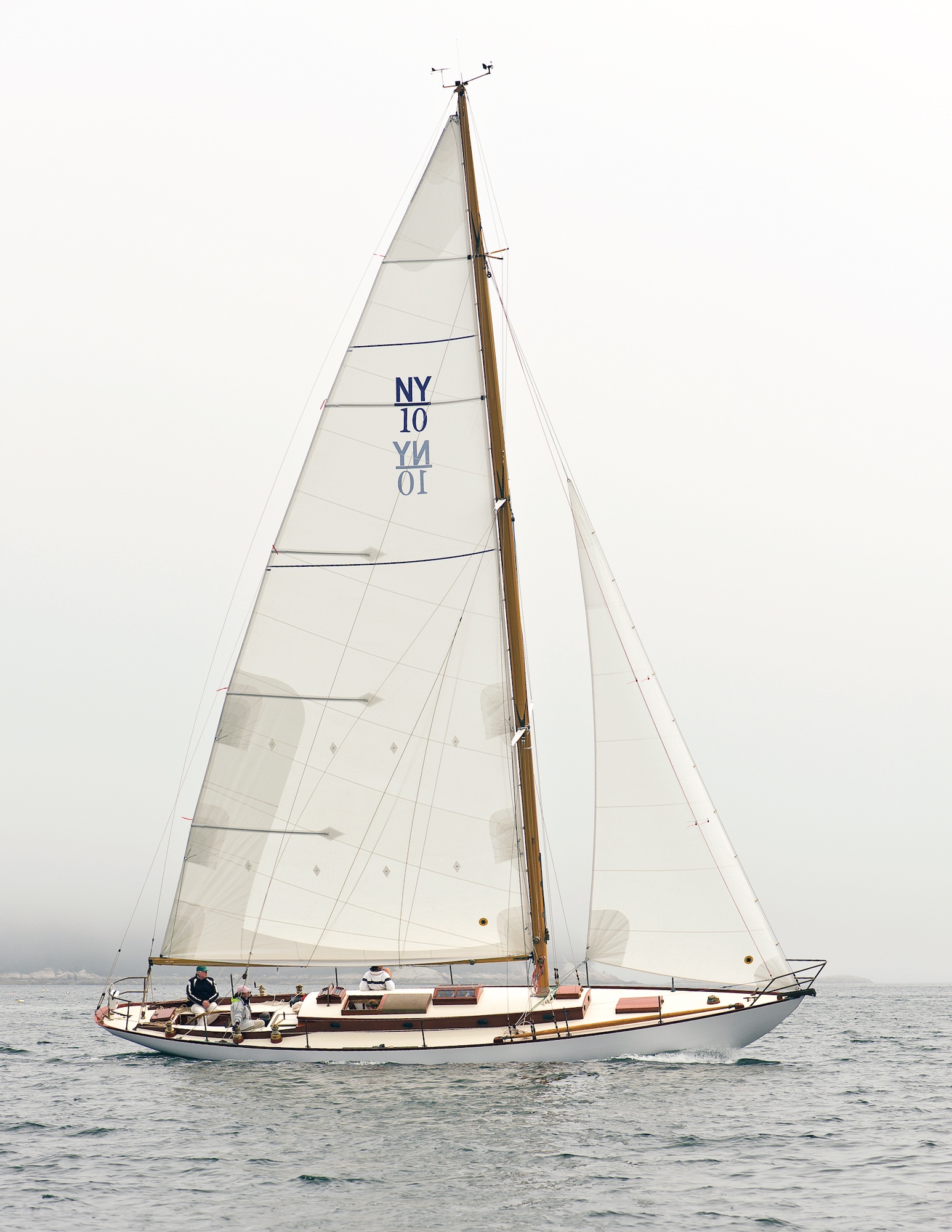
ISLA, New York 32 No.10 (of a total of 20), was thoroughly rebuilt last year by Buzzards Bay Yacht Services of Mattapoisett, Massachusetts. The job included a new mast, whose construction is detailed on the following pages.
W hen my company was hired to restore New York 32 No. 10, ISLA, in 2008, the boat had been out of service for over 25 years. The 20-boat New York 32 fleet was designed by Sparkman & Stephens in 1935 and built over the winter of 1935–36 by Henry B. Nevins of City Island, New York. When we found her, ISLA was a virtual time capsule, with an intact original interior and a complete set of original hardware. But the hull and deck were tired, to say the least, and the spars were beyond repair. So, included in the work list were a new mast and boom.
The New York 32 carries a hollow, oval mast measuring 63′ 5″. The owners were committed to maintaining ISLA’s originality, so we acquired the original spar drawings from the S&S plan collection at Mystic Seaport. These included ample detail: spreaders, tangs, boom, and masthead, along with the overall mast plan. The following steps describe how we turned those drawings into a new mast for ISLA.
Ordering and Preparing Lumber ISLA’s mast is built of Sitka spruce, which has long been prized by sparmakers for its long, clear lengths, light weight, and impressive strength for that weight. From the plans we developed a lumber list for the mast, boom, and spreaders. While it is still possible to acquire excellent-quality Sitka spruce, it takes some searching and a keen eye for defects. We required at least 12/4 stock to fashion the forward and after staves.
For spars, it’s imperative that the wood be dry (below 15 percent moisture content) and free of defects. The grain must be vertical. Our first attempt to procure lumber for this mast resulted in us receiving a batch of 12/4 Sitka spruce that was case-hardened. It was dry to both the touch and to the moisture meter, but once milled and its center exposed, its moisture content went off the scale. When we tried to rip it on the tablesaw, it pinched the saw’s blade and stopped the saw. We replaced that batch of wood with properly dried material, and learned a lesson in the process.
We ran the rough-sawn boards we had purchased through the thickness planer to take “fur” off of each one, allowing for a better inspection of the surface of the wood. When doing so, we kept in mind the minimum thickness of the staves, so we wouldn’t carelessly plane off too much. With this done, we examined each board, measuring its usable portion, marking visible defects, and labeling each piece for its intended location in the mast. A board with tight grain is slightly denser and thus heavier than one with wider ring spacing; we strived to locate these heavier pieces toward the bottom of the spar. If another board had slight grain runout, we’d consider using it in the mast’s heel where it is under less stress and is backed by solid blocking. It’s also important to keep in mind the locations of the scarfs when selecting the lengths of stock that will compose each stave, for the scarfs must be staggered.
Utilizing the Drawing
The drawing shown here is an illustration of the original Sparkman & Stephens mast plan for the New York 32, whose vertical scale was compressed in order to fit the mast’s dimensions onto a single sheet of paper. From the drawing we created a table of offsets for the mast. To do this we drew a series of stations, 5′ apart, perpendicular to the mast’s centerline. We did this for both the side and forward views of the mast.
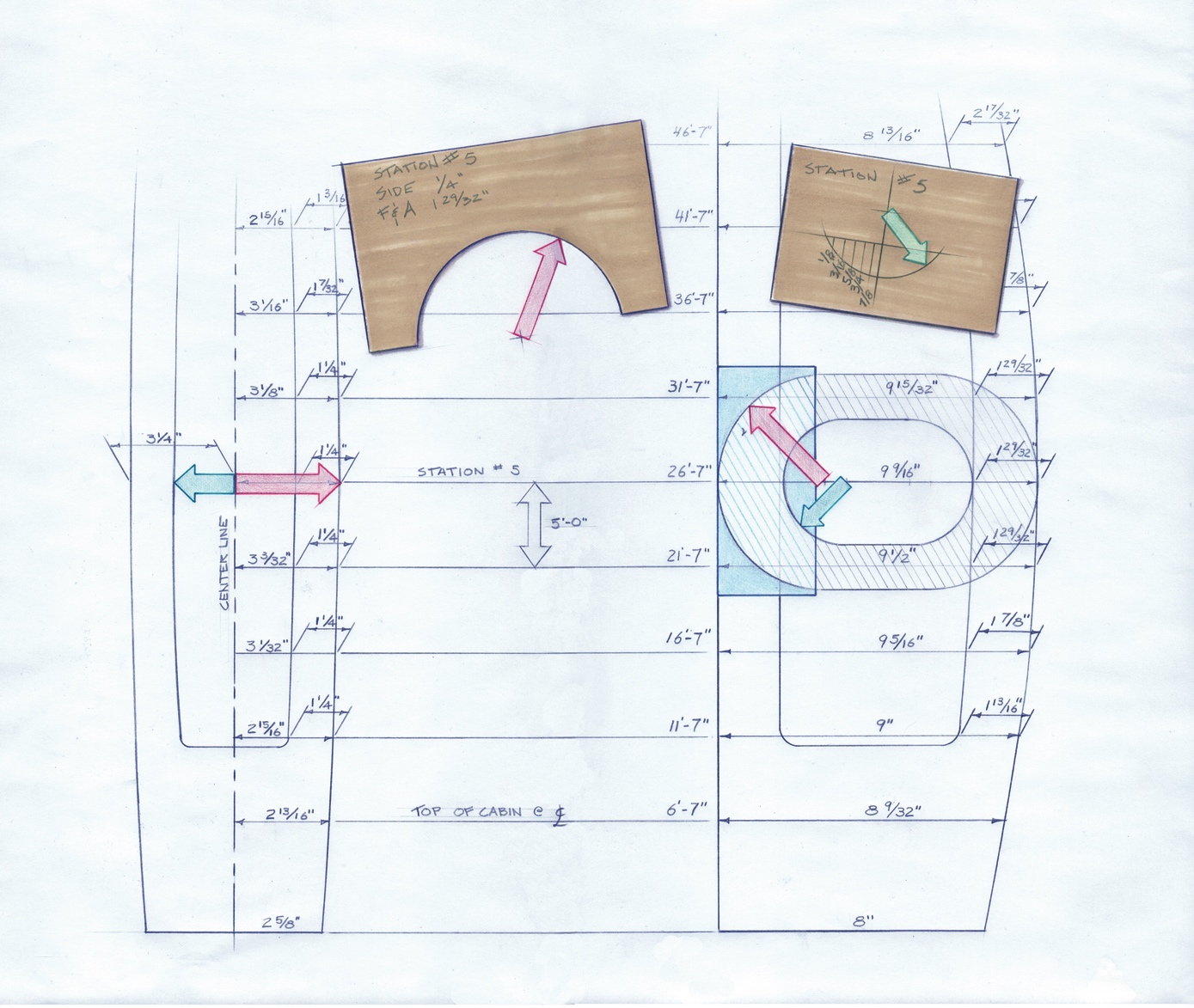
The drawing shown here is an illustration of the original Sparkman & Stephens mast plan for the New York 32
For the forward and after staves, we recorded the overall thickness of the stave (that is, its thickness before hollowing) and its half width. For the side staves, we recorded the thickness and width at each station. We converted the mast plan drawing from 32nds of an inch to decimal units, which I find best when working to close tolerances using digital calipers. We then made up 10″ × 10″ lauan templates on which to draw the sectional shape of the mast at each station. Since the forward and after profiles are arcs of a circle, we transferred these shapes from the drawing to the lauan with the aid of a compass. After each shape was transferred we cut out these lauan templates with a bandsaw. On each template, we also recorded the sidewall thickness, forward and after wall thicknesses, and distance from the heel of the mast. Building this New York 32 mast as was done originally requires hollowing out the thick forward and after staves in order to lighten their weight. So, once again using the mast plan, we made templates for the mast’s inside shape at each section.
The Spar Bench
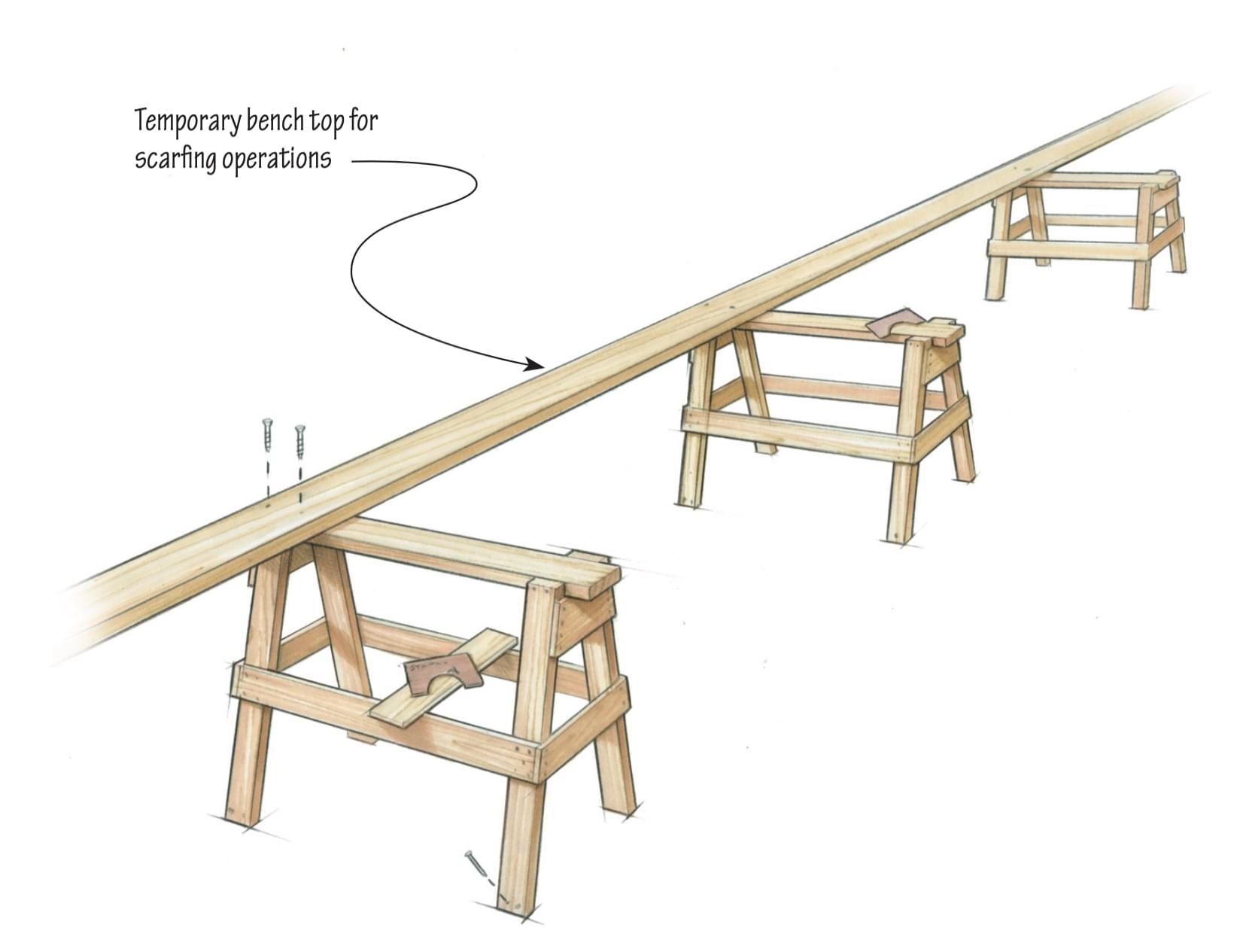
The first step in building the mast is to construct a spar bench. We wanted a sturdy bench that was straight and set at a good working height. Typically, a spar bench comprises a series of sturdy sawhorses spaced 5′ apart and fastened securely to the shop floor. Identical wooden sawhorses work well for this; once they were secured to the floor, a mason’s string was run to assure that the tops were all in the same plane; the tops were then shimmed as needed to achieve this. The 2 × 10 plank seen here being screwed to the sawhorses is to support the staves during the scarfing operation, and will later be removed.
Gluing Up Full-Length Staves
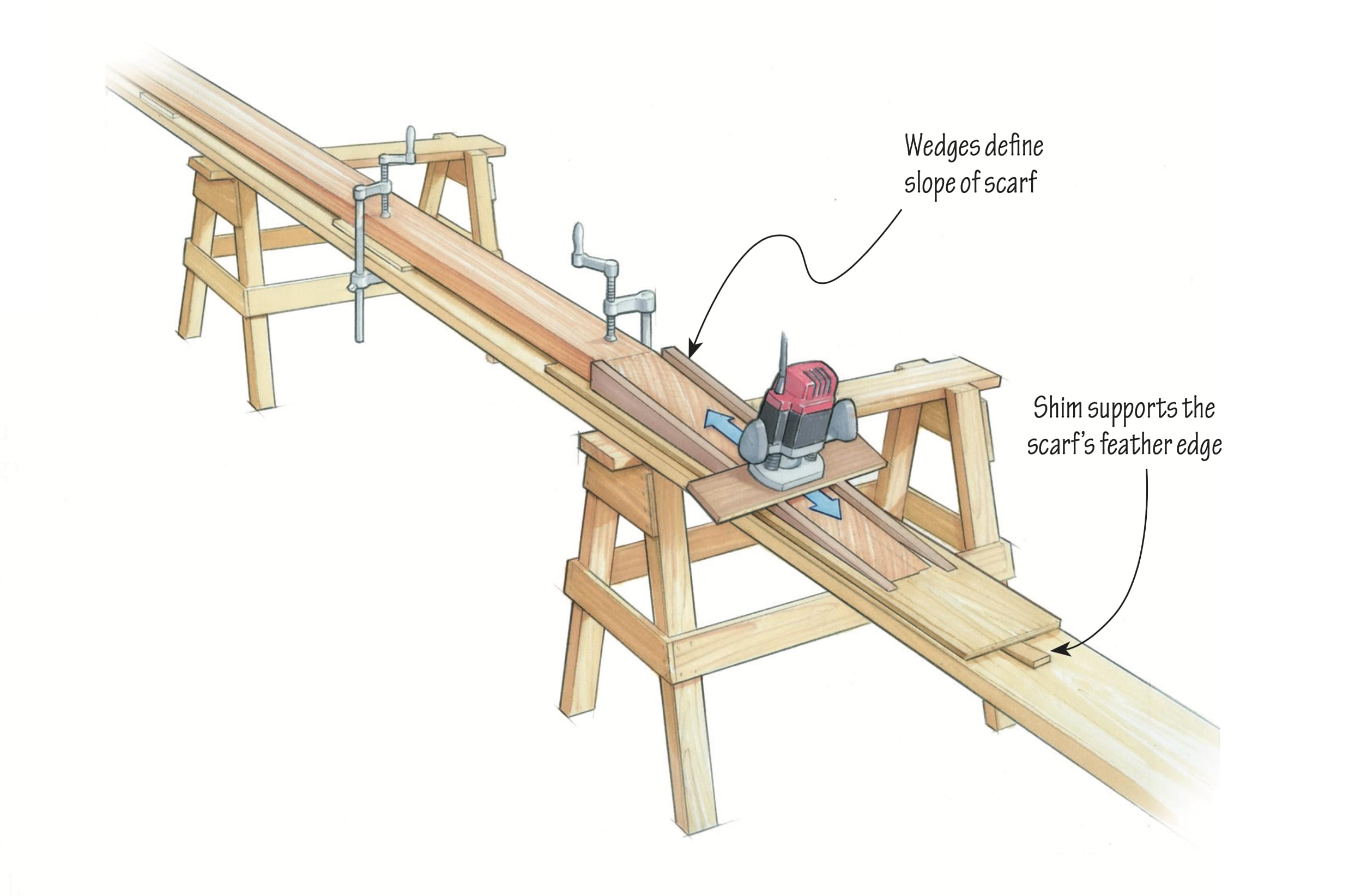
On our nice, solid bench, we laid out the wood for each of the mast’s four staves end-to-end and developed a final scarf plan. We planed the stock to the maximum designed thickness for the forward and after staves (2.875″) and for the side staves (1.25″). Then we scarfed the stock together to create the full-length staves. Careful layout and labeling were required for this step. We examined the stock and put the most visually pleasing sides facing out, and we spread out the scarf locations to avoid clustering them. Scarfs were cut to a slope of 12 to 1, with their lines drawn onto the edges of each piece. They were rough-cut on the bandsaw, and then finished with a jig and a router. With the scarfs cut, we assembled the pieces dry and ran a string down each of their centerlines to confirm that each of the four full-length staves, once glued, would be straight.
When we were certain that the staves would be straight and true, we screwed blocks to the spar bench to chock them in place. The individual pieces could then be removed from the bench, turned over for gluing, and placed back in their precise positions. The final step in preparing the scarf for epoxy glue was to rough up the surface of the glue joint. Eighty-grit sandpaper backed by a long block works well for this, as does the technique we used: a Japanese pull saw drawn across the grain so its teeth combed the surface. (This process is for epoxy gluing only; resorcinol and other glues rely on smooth mating surfaces.)
Once the surface was roughed up, we vacuumed both faces of the joint and then wiped them with a clean rag and denatured alcohol until the rags came up clean. We then wet out both gluing surfaces with straight epoxy and allowed that to stand for several minutes while it penetrated the wood. Dry spots were wetted a second time. We then applied epoxy thickened with colloidal silica to one face of the joint. Using large bar clamps and modest pressure, we clamped the joints, making sure we had a nice, even glue squeeze-out.
Tapering the Staves
Once the staves were glued full-length, we selected the aft stave, blocked it straight on the spar bench, and snapped a centerline. Then, using the information from the lauan templates and the offset table, the points representing the stave’s profile were laid out and connected with a long, limber batten. One of the side staves was marked similarly.
We rough-cut the profiles with a worm-drive circular saw being careful to leave the lines intact. We then cut closer with a power plane, and then shaved precisely to the lines with an appropriate hand plane, making sure that the edges stayed perfectly square. With one stave of each profile now complete, we used each as a template for its mirroring stave, making the final cuts with a router and bearing bit to complete the second pair of staves.
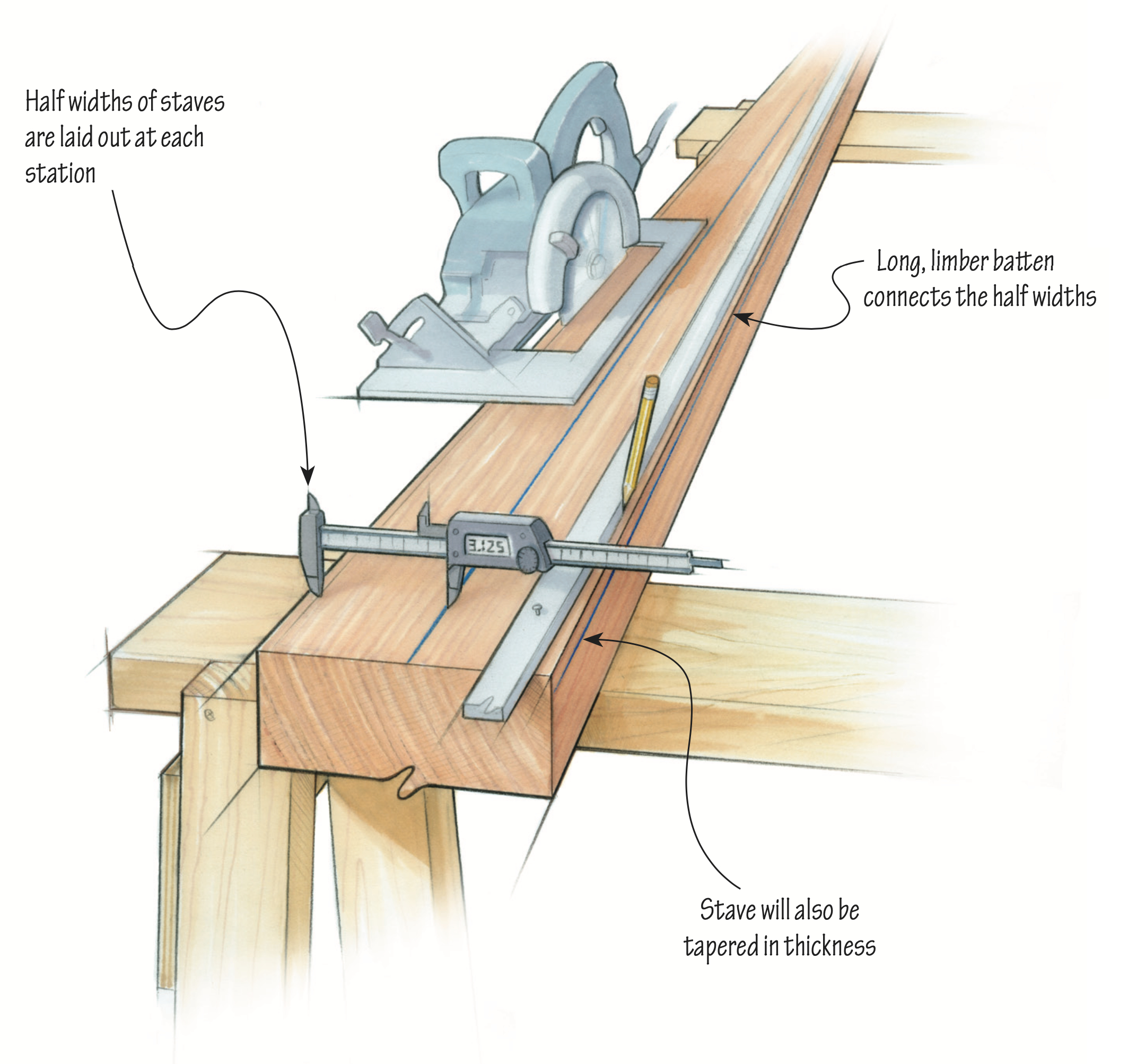
To minimize weight aloft, the wall thickness diminishes as we progress up the mast. Once again we turned to the lauan templates on which we’d recorded the wall thickness at each station. Using digital calipers, we recorded on both edges of each stave the wall thickness at each station and connected the dots with our long batten.
This line, yet to be cut, is shown in the drawing. The stock was removed from the outside faces of the staves, the bulk of it with a power plane. The final cleanup was completed with a bench plane.

Rabbeting the Forward and After Staves
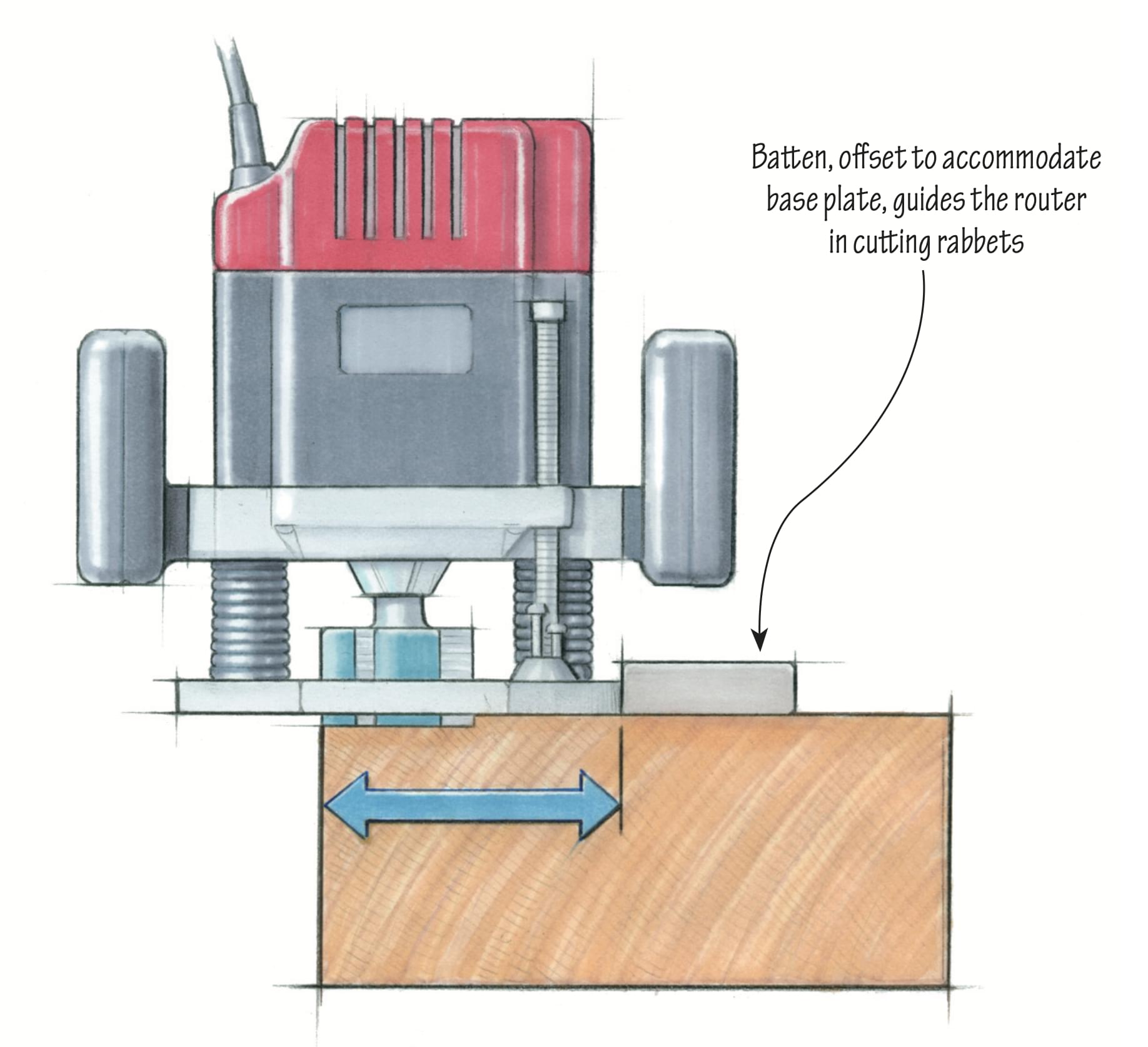
Hollowing the Forward and After Stave
The final step before gluing the staves together was to hollow out the forward and after staves. On the lauan templates we referred to the inside profile shapes we had recorded from the mast drawing. Dividing the inside profile into 1⁄4″ sections, we measured and recorded the depth at each section. We did this at each station. The inside face of the stave was thus lined off in 1⁄4″ increments.
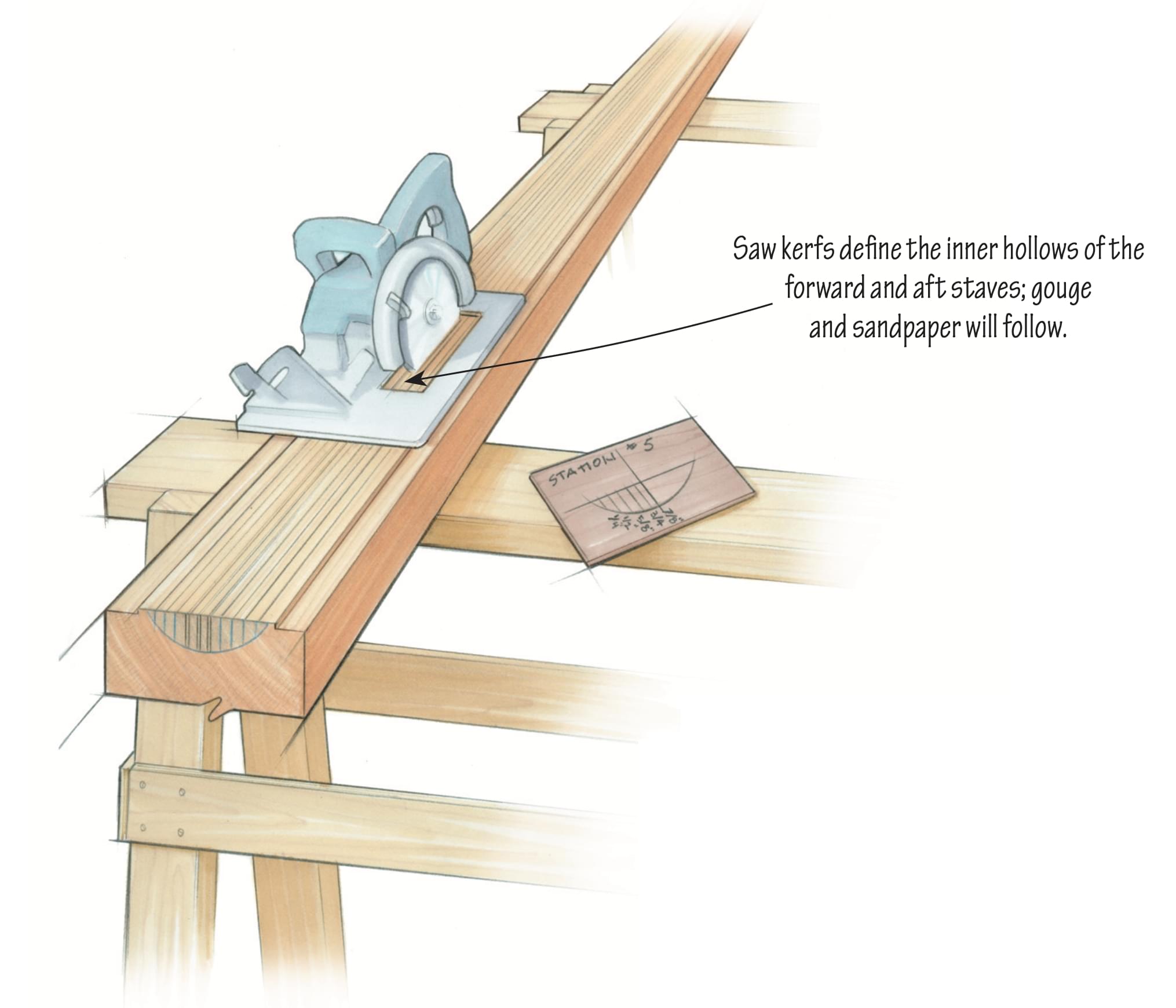
Then, using a circular saw set at the depth indicated by the lauan template, we cut kerfs in the inside face of the stave. With each pass of the saw, we reduced the depth of the cut as we moved toward the masthead and farther from the center of the stave. With the kerfs completed, we used a gouge to scoop out the waste. We arrived at the final shape by using a backing-out plane followed by 80-grit sandpaper on a round sanding block.
With the staves cut to their profiles and tapered in thickness, and the forward and after staves rabbeted and hollowed, we double checked that the spar bench was still straight. The next step was to lay the after stave on the bench, sail-track side down, and hold it straight with blocks screwed to the bench so the spar could not move. We then did a final dry-fit of the three remaining staves to make sure all joints were tight.
When satisfied with the bench and the joints, we began mixing glue. A large spar such as this takes about four people to glue up; any fewer, and panic would certainly ensue. The glue-up seems to work best as a two-step process. The first step was to glue the side staves to the after stave, using the forward stave as a dry-fitted guide to ensure that the side staves remained parallel. We clamped the spar in 1′ increments, checking that it remained square along its entire length. Using the two-step process allows ample time to fit and install the solid blocking at the head and heel of the mast. The drawing calls for blocking in the bottom 11′ of the spar and in the top 2′ 6″.
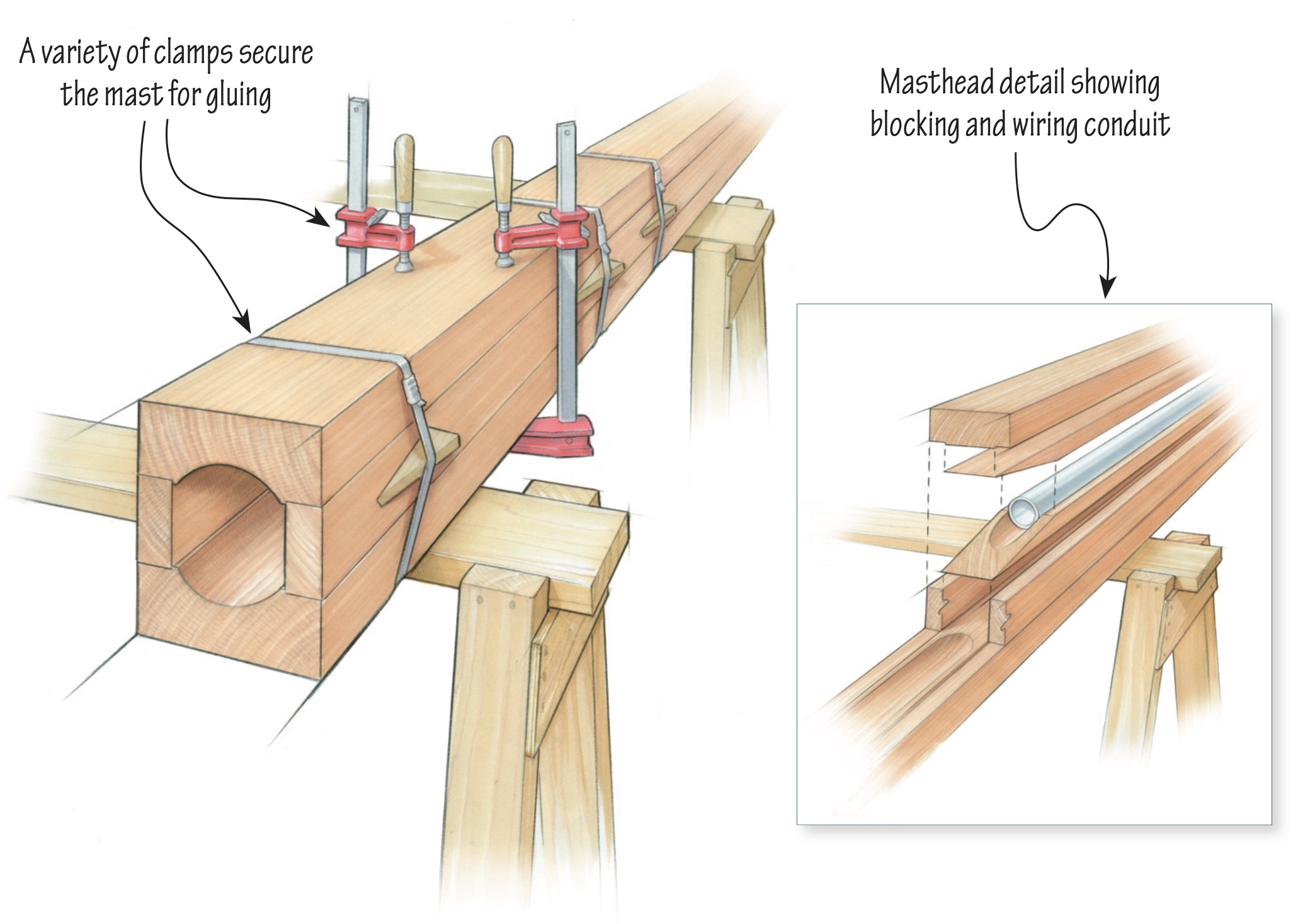
The blocking is solid until about the final foot, where it tapers to a feather edge on either side of the spar, forming a swallow-tail shape to avoid a hard spot. This heel blocking has a drain hole, in case of water intrusion. There is no blocking at the spreaders; instead, the spreaders have an external bracket and blocking system that transfers the load evenly to the spar.
We coated all interior surfaces with epoxy. At this stage, we also ran all of the wires inside the mast, securing them with large cable clamps. (Conduit fastened securely along the interior of the spar—and through the blocking—works well for this, too.) When everything was satisfactory inside the mast, the forward stave was glued to the side staves to cap the assembly. Several varieties of clamps can be used when gluing up a spar: spar clamps, bar clamps, C-clamps, or a banding tool. We used a combination of clamps and a banding tool supplemented with wedges to further tension the plastic band.
With the glue cured and the clamps off, it was time to begin the shaping process. The first step was to plane off the excess glue. With that done, we again turned to our handy lauan templates and began the process of eight-siding the spar. Using the exterior cross-section drawn on each template, we found where a 45-degree line would be tangent to the mast’s outside surface at each station. We transferred these points to the spar, and with the long batten connected them with fair lines.
We then set our circular saw to 45 degrees and made a cut, just leaving the line. Repeating this on all four sides of the mast, and then fairing up the saw cuts with a power plane followed by a hand plane, yielded an eight-sided spar. We then lined the spar off again to 16 sides, but this time we omitted the circular saw and removed the waste with only a power plane. When we had the spar 16-sided, we finished the rounding and fairing with hand planes and a custom-built concave fairing board. Once again our lauan templates came into play, as we used them to confirm the correct shape at each station. Two other details that had to be considered at this stage were the shape of the heel of the spar, and the masthead detail.
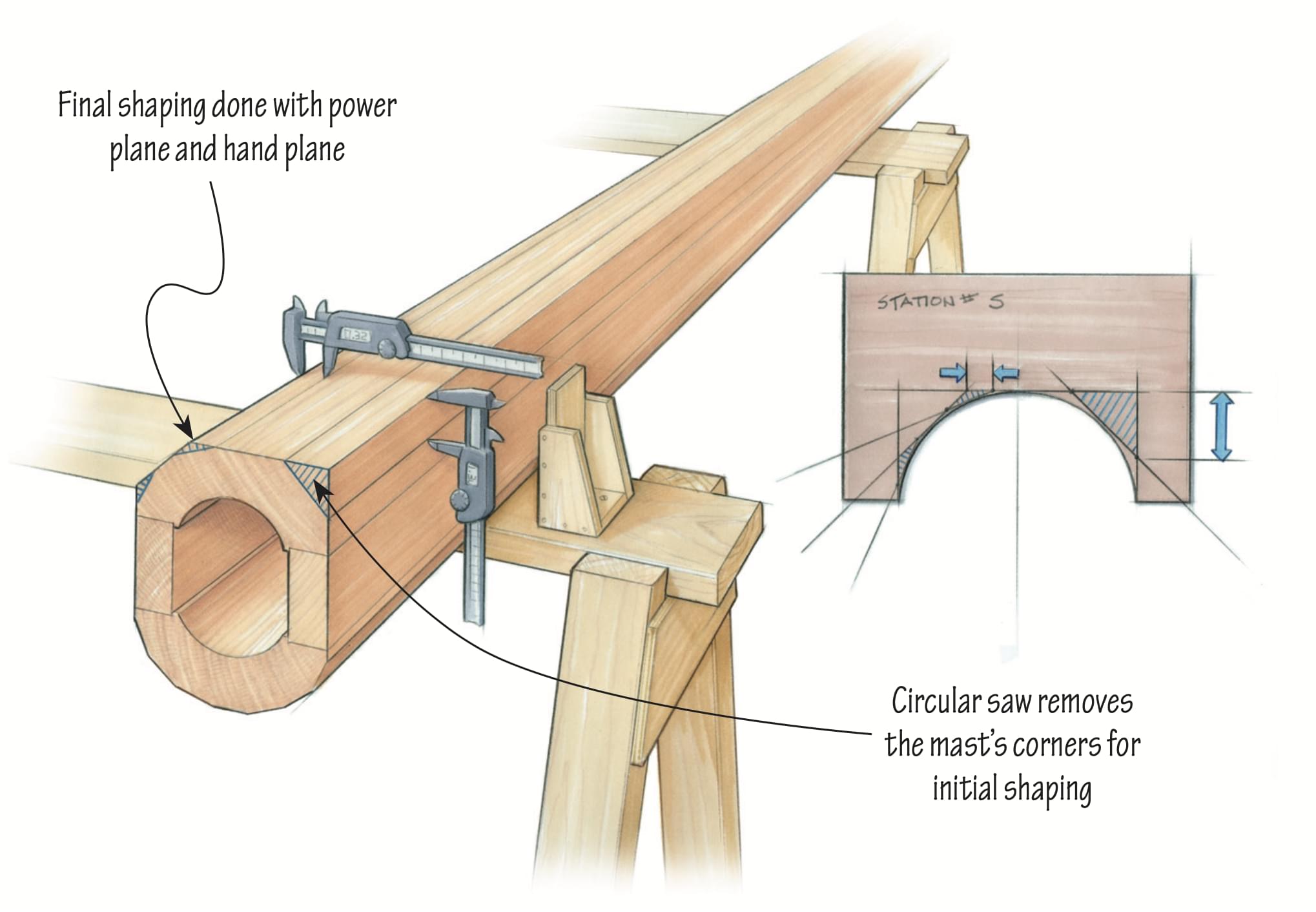
With the mast now shaped and sanded, we broke out the varnish and applied 10 coats before installing the track and hardware. We were fortunate to have all of the original tangs and other fittings for this spar, because fabricating them would have required quite a bit more work. With the spar varnished the hardware was installed, carefully bedded in soft compound. We were very careful in fastening into the Sitka spruce, as it is quite soft. We chose machine screws rather than wood screws for mounting the winches and the boom gooseneck track—after testing these fastenings on offcuts to find the best pilot-hole diameters.
This article was originally published in WoodenBoat No. 214, May/June 2010.
Related Articles
Bung removal with the rotabroach sheet-metal hole cutter, ten things that can hurt your wooden boat, one-off wood-and-canvas construction, a sliding tool tray, related videos, making the north woods paddle, tools of the boatbuilding trade, making a stem, east passage 24, related book chapters, hatches and other deck joinery, deck framing, laying the deck, subscribe for full access.
Flipbooks are available to paid subscribers only. Subscribe now or log in for access.
Review of New York 32
Basic specs., sailing characteristics.
This section covers widely used rules of thumb to describe the sailing characteristics. Please note that even though the calculations are correct, the interpretation of the results might not be valid for extreme boats.
What is Theoretical Maximum Hull Speed?
The theoretical maximal speed of a displacement boat of this length is 7.7 knots. The term "Theoretical Maximum Hull Speed" is widely used even though a boat can sail faster. The term shall be interpreted as above the theoretical speed a great additional power is necessary for a small gain in speed.
The immersion rate is defined as the weight required to sink the boat a certain level. The immersion rate for New York 32 is about 211 kg/cm, alternatively 1185 lbs/inch. Meaning: if you load 211 kg cargo on the boat then it will sink 1 cm. Alternatively, if you load 1185 lbs cargo on the boat it will sink 1 inch.
Sailing statistics
This section is statistical comparison with similar boats of the same category. The basis of the following statistical computations is our unique database with more than 26,000 different boat types and 350,000 data points.
What is L/B (Length Beam Ratio)?
Maintenance
Are your sails worn out? You might find your next sail here: Sails for Sale
If you need to renew parts of your running rig and is not quite sure of the dimensions, you may find the estimates computed below useful.
This section shown boat owner's changes, improvements, etc. Here you might find inspiration for your boat.
Do you have changes/improvements you would like to share? Upload a photo and describe what to look for.
We are always looking for new photos. If you can contribute with photos for New York 32 it would be a great help.
If you have any comments to the review, improvement suggestions, or the like, feel free to contact us . Criticism helps us to improve.
newyork32.org
Links & References
Sparkman and Stephens, Inc Sparkman and Stephens association Sparkman and Stephens Club Italia
Classic Rating Formula Classic Yacht Owners Association (CYOA)
Abbreviations
AYC — American Yacht Club BYC — Bayview Yacht Club CCA — Cruising Club of America CSHBC — Cold Spring Harbor Beach Club DYC — Detroit Yacht Club EYC — Eastern Yacht Club LYC — Larchmont Yacht Club NAYRA — North American Yacht Racing Association NYYC — New York Yacht Club OSC — Off Soundings Club PHYC — Port Huron Yacht Club SCYC — Seawanahaka Corinthian Yacht Club STC — Storm Trisail Club YRA of LIS — Yacht Racing Association of Long Island Sound

Sailboats For Sale New York
20 listings found.
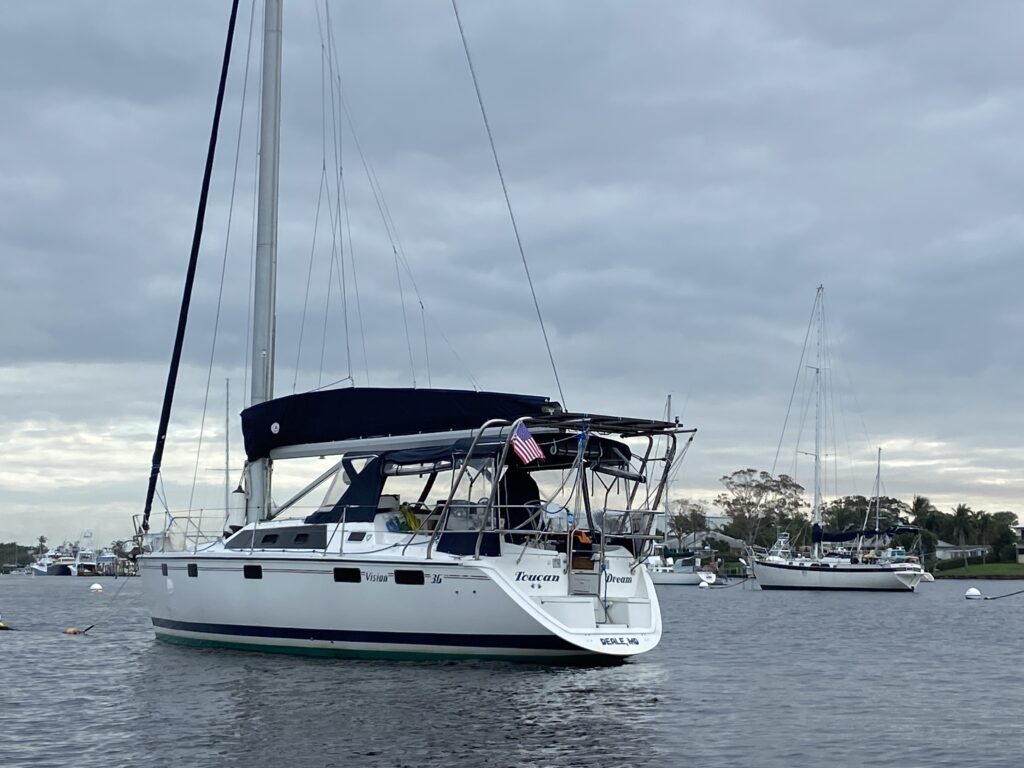
36 Hunter Vision 1993

Hobie Mirage Tandem Island
- Florida , United States

1972 Luders 36 by Cheoy Lee

Tartan 10 Snowballs Chance
- Connecticut

1975 Bristol 32 Sloop, Keel/CB by Ted Hood (Am’s Cup)

- Massachusetts

Used Yamaha 200 HP 4-Stroke Outboard Motor Engine
- United States

Used Yamaha 115 HP 4-Stroke Outboard Motor Engine

33ft Blue Water Sailboat

Freshwater Only – 1989 Hunter 33.5 Sloop-Rigged Cruiser, Shoal Wing Keel

F&C 44′ Ketch

Reeds Cub Scow – SOLD

Melges C Scow
470 sailboat and trailer
- Pennsylvania

1978 Hunter 30 Cheurbini
Sold – Shallow Draft Cat Ketch 24 Cruiser

1981 Pearson Flyer
Catalina 27 for sale

Hunter 44 DS perfect to live aboard!

New and Used Sailboats For Sale
New York can be considered one of the best states to own a sailboat. New York is the only state to offer sailors the saltwater of the Atlantic Ocean and fresh water of the Great Lakes. Because of this, the state of New York offers a wide variety of options for sailing.
No matter what your sailing plans are, SailTrader has a new or used sailboat for sale in New York to suit your needs. Find sailboats near you or for sale nationally.
- Cruising Sailboats
Cruising sailboats are a popular choice for many sailors looking to get on the water with friends and family. For some sailors this means either an afternoon sail or a multi-day adventure. No matter what you’re sailing agenda is, you’re sure to find a variety cruising sailboats for sale in New York on SailTrader. Browse sailboats from popular cruising brands like Hunter, Catalina, Beneteau, Jenneau, Swan, Cal, Tarten, Pearson and more.
- Racing Sailboats
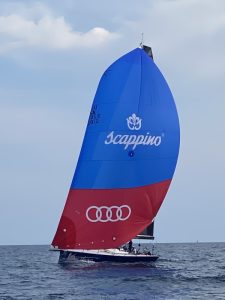
One Design Sailboats
One Design sailboats can often provide the best chance to learn and improve your racing skills. It’s common to find one design racing sailboats near larger bodies of water. Search sailboats for sale in New York from popular one design classes like the J24, J70, Tarten Ten, J105, J111, Melges 24 and more.
Dinghy’s are a often preferred due to the convenience and low maintenance costs. There are different classes that can offer a range of benefits and regattas. Browse dinghy’s for sale in New York like Thistles, Lightnings, Flying Scots, Scows, Optimists, 420’s, Lasers, VX Ones and more. Dinghy’s are also a popular choice in areas of New York that have small bodies of water. For racers, the cost of new sails for a dinghy are far less then a large racing sailboat. Search SailTrader for your next dinghy sailboat.
Catamarans and Trimarans
Both catamarans and trimarans can be a great choice no matter if you’re a racer or cruiser. Racing multihulls are fast and light while cruising catamarans are wide and comfortable. SailTrader makes it easy to find the right catamaran or trimaran sailboat for sale in New York. We cater exclusively to sailors so you’ll find the latest and most recent sailboats available.
The Sailor's Choice For Sailboats For Sale in New York
SailTrader is exclusively designed to makes it easy for dealers and to privately sell a sailboat . Browse local New York sailboat listings above or search sailboat listings nationwide.

The Sailor’s Marketplace for Sailboats and Sails.
Sell Your Sailboat
Sailboats for sale.
- New Sailboats
- Used Sailboats
Sell Your Sails
Sails for sail, sail manufacturers.
- North Sails
- Quantum Sails
- Doyle Sails
- UK Sailmakers
Sailing Reviews
- Sailing Line
- Safety Equipment
- Sailing Accesories
As an Amazon Associate SailTrader earns from qualifying purchases.
This website uses cookies to ensure you get the best experience possible.

IMAGES
VIDEO
COMMENTS
Learn about the New York 32, a classic blue water racing sailboat designed by Olin Stephens and built by Henry B Nevins in 1935. Find out the history of the Nevins Yard, the Ratsey & Lapthorn Sail Loft, and the design specifications of the New York 32.
SIRIUS is a classic 1930s design by Sparkman & Stephens, built by Henry B. Nevins and restored by Cantiere Navale in Argentario. She has a mahogany interior, a Yanmar diesel engine, and a history of racing in the New York Yacht Club and the Mediterranean.
Learn about the NEW YORK YACHT CLUB 32, a classic wooden sailboat designed by Sparkman & Stephens and built by Henry B. Nevins in 1935. Find out its hull type, rigging, LOA, beam, displacement, auxiliary power, sail area, comfort ratio, capsize screening, and more.
2010 Sparkman & Stephens New York 32 for sale. Used 2010 Sparkman & Stephens New York 32 for sale with the beautiful name "MASQUERADE" is located in Kingdom of the Netherlands.This vessel was designed and built by the Sparkman & Stephens shipyard in 2010. Key features 2010 Sparkman & Stephens New York 32: length 13.82 meters, beam 3.2 meters and max boat draft 1.7 meters.
New York 32 Boats Review and Specs. New York Boats for Sale Craigslist & New York Specs & Pictures. Year: 1936. Manufacturer: Cannell, Payne & Page Yacht Brokers. Price: US$150,000. GENTIAN GENTIAN is one of the highly regarded New York 32's which were designed by Olin Stephens and built by the Henry B Nevins yard in New York.
After speaking with Skip Gmiener, owner of Apache NY 32 Hull #2, on a Monday, ... 1936, as part of a 20 boat fleet commissioned by the New York Yacht Club. Apache sailed the Bermuda Race that year (the first year the race started in Newport) and finished 2nd of 44 boats. This edition was also the famed Bermuda Race that gave us the Storm ...
Mustang is hull number 17 of the one-design New York 32 series that produced only 20 hulls in 1936. The boats were specifically commissioned by the New York Yacht Club to replace their aging Herreshoff-designed fleet of "Thirties" (built in 1905). ... Mustang is a significant and capable boat with a six foot, six inch draft, a 24,550-pound ...
Presentation made by Skip Gmeiner at the Grosse Pointe Yacht Club about the history of the sailboat 'Apache'. Build in 1936, the Gmeiner family has owned he...
The New york yacht club 32 is a 45.33ft fractional sloop designed by Olin Stephens and built in wood by Nevins Inc. between 1935 and 1936. 20 units have been built. The New york yacht club 32 is a heavy sailboat which is a good performer. It is not stiff and has an excellent righting capability if capsized. It is best suited as a heavy ...
Sparkman and Boats for Sale Craigslist & Sparkman and Specs & Pictures. Year: 1936. Manufacturer: Sandeman Yacht Company Ltd. Price: US$250,000. MUSTANG is famous - not only as one of the small fleet of NY 32s designed by Olin Stephens as the club boats for the New York Yacht Club in 1936 but as his brother Rod's own race winning boat for ...
New York Yacht Club 32 is a 45′ 4″ / 13.8 m monohull sailboat designed by Sparkman & Stephens and built by Nevins Inc. between 1935 and 1936. ... The lower a boat's ratio is, the less power it takes to drive the boat to its nominal hull speed or beyond. Read more. Formula. D/L = (D ÷ 2240) ÷ (0.01 x LWL)³ D: Displacement of the boat ...
The New York 32 #1 - Valencia #2 - Apache #3 - Ice Fire #4 - Tigress #5 - Vitesse #6 - Falcon ... Alum's Passion to Restore an Old Sailboat Leads Him on a Circuitous Journey. ... The History of The New York Yacht Club from its founding through 1973. NYYC publisher. 622 pp in two volumes. 1975. Henderson, Richard "Jud".
The 20-boat New York 32 fleet was designed by Sparkman & Stephens in 1935 and built over the winter of 1935-36 by Henry B. Nevins of City Island, New York. When we found her, ISLA was a virtual time capsule, with an intact original interior and a complete set of original hardware. But the hull and deck were tired, to say the least, and the ...
The l/b ratio for New York 32 is 4.33. Wide Slim 100% 0 50 100. Compared with other similar sailboats it is slimmer than 100% of all other designs. It seems that the designer has chosen a significantly more speedy hull design. This type of design is also referred to as 'needle'.
This vessel was designed and built by the New York shipyard in 1936. Key features 1936 New York 32: length 13.72 meters. engine: fuel type - diesel. 1936 New York 32 refers to classes: sailboats, sailing yachts and sailing sloops. To clarify the price $172,500 and buy New York 32 - contact the offerer!
Your search returned 1196 matches of 103637 sailboats posted to date. Pages: 1
Price. 1991. 32'. 14'. 2.5'. New York. $34,000. Description: 32ft Carlson catamaran (a reworked Iroquois) in good condition,retractable rudders,swing keels.Recently redid the interior.Some trim work needs to done and a little wiring to complete.Rewired the mast.Running rigging in good condition.Put it in the water and sail away.Finish as you go ...
Price. 1981. 32'. 10.5'. 3.9'. New York. $6,500. Description: VERY low price for this boat! recenty all standing rigging was replaced using sta-lock fittings. recent bottom paint hull job. lower bootstripe just redone using gelcoat and upper stripe redone using 2 part polyurethane.
NAYRA — North American Yacht Racing Association. NYYC — New York Yacht Club. OSC — Off Soundings Club. PHYC — Port Huron Yacht Club. SCYC — Seawanahaka Corinthian Yacht Club. STC — Storm Trisail Club. YRA of LIS — Yacht Racing Association of Long Island Sound.
2003. 32'. 11'. 5.9'. New York. $49,500. Description: Are you ready to embark on a journey where every wave tells a story, and every gust of wind carries the promise of adventure? Look no further than the 2003 Bavaria 32 Sailboat, a vessel meticulously crafted to awaken your passion for the sea.
Racing and cruising sailboats for sale in New York. Find new and used sailboats from private sellers and from dealers. Browse listings. ... 1975 Bristol 32 Sloop, Keel/CB by Ted Hood (Am's Cup) $8,000.00. Florida. Skimmer $14,000.00. Massachusetts. Used Yamaha 200 HP 4-Stroke Outboard Motor Engine $8,200.00.
Preowned sailboats for sale by owner located in New York. Home. Register & Post. View All Sailboats. Search. ... 32' PDQ 32 Classic Port Charlotte, Florida Asking $95,000. 39' Beneteau 393 Antigua ... New York Asking $74,500. 31.33' kirie Elite yacht 326 quebec Asking $39,900.